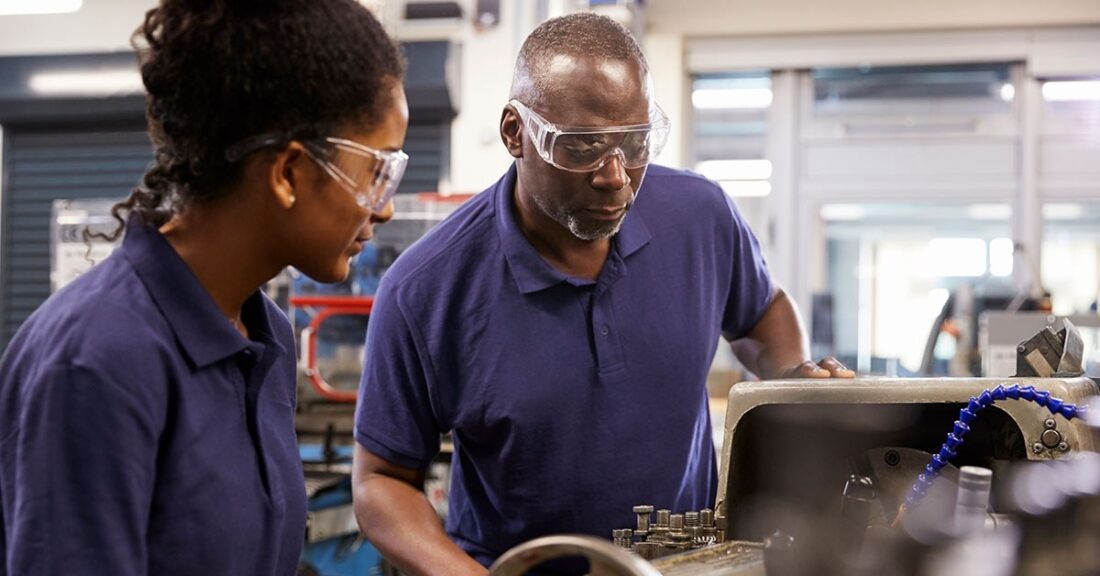How Youth Apprenticeships Are Bringing Students to Work

Phillip Fuller was in high school when he started his apprenticeship with Bright Plastics, a North Carolina-based plastic injection company. Fuller and his employer were brought together by the Guilford Apprenticeship Program, one of many initiatives supported by the Partnership to Advance Youth Apprenticeship (PAYA) — a network that promotes high-quality apprenticeship opportunities for high-school-age youth across the country.
Since its launch in 2018, PAYA learning network members have matched hundreds of young people and employers across the nation. In addition to helping employers find new talent, PAYA wants to grow the number of quality apprenticeship opportunities for high schoolers and raise awareness of how these opportunities can spur a more equitable and inclusive economy.
Advancing Equity through Youth Apprenticeship
In today’s job market, many employers are looking for candidates with a college degree or specialized training. These expectations are often a roadblock for young people from low-income families, who struggle to afford the rising cost of tuition and may not have the job experience or professional connections needed.
What’s more, prospective college students face daunting obstacles — including shrinking financial aid and the heavy burden of student loan debt — that may prevent them from completing their degree or credential.
Youth apprenticeships combat these challenges by combining compensated, hands-on training with critical classroom learning to give students the tools and skills they need to succeed as working adults.
“Youth apprenticeships are an incredibly important equity tool,” says Allison Gerber, who oversees the Annie E. Casey Foundation’s national employment, education and training work. “For young people from low-income communities, especially youth of color, apprenticeships can help diversify talent pipelines and create affordable pathways to and through college.”
For Fuller, his apprenticeship with Bright Plastics was a “win-win situation” — an opportunity to start a career and earn a college degree without having to worry about the high cost of tuition.
“In my junior year, I was invited to learn more about the Guilford Apprenticeship Partnership by one of my school’s career development coordinators,” says Fuller. “I was on the fence at first, but I decided to give it a shot because of the opportunities it would afford me. The program would pay for me to attain my associate degree, I would receive guaranteed raises every year and I would get practical, on-the-job training.”
Each week, Fuller divided his days between high school classes and shifts at Bright Plastics. While balancing classes and six-hour shifts wasn’t always easy, he found that he advanced quickly thanks to the support of his apprenticeship program and his mentors in the workplace. In just five years, Fuller went from learning the basics to supervising his own shifts on the factory floor. He also earned his associate degree in manufacturing technologies from Guilford Technical Community College.
With valuable work experience under his belt, Fuller now plans to work towards a bachelor’s degree in industrial engineering at North Carolina A&T State University. The school is a short drive from Bright, which will allow him to continue working as he transitions from a shift supervisor to a sales role within the company.
“I really like to speak with people and wanted to travel, so we thought that this would be a good next step in my career. In ten years, I would like to be in upper-level management with Bright Plastics and I think the path I’m on will help me get there.”
What’s Ahead for PAYA?
PAYA’s efforts have not been without challenges. The COVID-19 pandemic has dramatically affected local economies — from labor shortages to slowdowns in nearly every industry — making it difficult for some employers to find the time to invest in mentoring and supervising youth apprentices.
“The biggest obstacle with youth apprenticeship is gaining buy-in amid an uncertain, ever-changing landscape,” says Gerber. “With employers, we’re helping them see the tangible benefits they can realize by investing in youth talent,” says Gerber. “With schools and students, our challenge is making apprenticeships work within existing education systems. Though PAYA grantees have made huge strides implementing policy and funding changes to support apprenticeships, the chaos that the pandemic has created has slowed uptake.”
Despite these bumps in the road, PAYA partners hope to support 10,000 youth apprenticeships across the nation by 2025 in a diverse range of industries, including agriculture, financial services, hospitality and tourism. PAYA is also focused on incorporating the voices and perspectives of young people to shape future plans.
As a first step, PAYA recently held its inaugural Youth Apprentice Voice Design Sprint, a ten-week co-design process that allowed young people, educators, employers and advocates to brainstorm ways to combat inequity in youth apprenticeship recruitment.
The effort culminated in several key takeaways about effectively engaging young people in design and decision-making processes, including the importance of establishing common and clear expectations.






